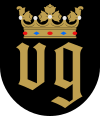Naantali
| Naantali | |||
|---|---|---|---|
| — City — | |||
| Naantalin kaupunki | |||
| Images, from top, left to right: Naantali’s medieval stone church and SS Ukkopekka, Jöns Budde statue, Särkänsalmi bridge, the guest harbour and Old Town of Naantali, Moomin's haus in Moomin World (Muumimaailma), Naantali Old Town and Archipelago of Naantali. | |||
| |||
| Nickname(s): The Sunshine Town | |||
| Location of Naantali in Finland | |||
| Coordinates: 60°28′N 022°02′E / 60.467°N 22.033°ECoordinates: 60°28′N 022°02′E / 60.467°N 22.033°E | |||
| Country | Finland | ||
| Region | Finland Proper | ||
| Sub-region | Turku sub-region | ||
| Charter | 1443 | ||
| Government | |||
| - Town manager | Timo Kvist | ||
| Area(2010-01-01)[1] | |||
| - Total | 638.08 km2 (246.4 sq mi) | ||
| - Land | 283.47 km2 (109.4 sq mi) | ||
| - Water | 354.61 km2 (136.9 sq mi) | ||
| Area rank | 191st largest in Finland | ||
| Population (2010-10-31)[2] | |||
| - Total | 18,515 | ||
| - Rank | 60th largest in Finland | ||
| - Density | 65.32/km2 (169.2/sq mi) | ||
| Population by native language[3] | |||
| - Finnish | 97.4% (official) | ||
| - Swedish | 1.4% | ||
| - Others | 1.2% | ||
| Population by age[4] | |||
| - 0 to 14 | 18% | ||
| - 15 to 64 | 66.1% | ||
| - 65 or older | 15.9% | ||
| Time zone | EET (UTC+2) | ||
| - Summer (DST) | EEST (UTC+3) | ||
| Municipal tax rate[5] | 17.25% | ||
| Website | www.naantali.fi | ||
Naantali (Finnish pronunciation: [ˈnɑːntɑli]; Swedish: Nådendal) is a city in south-western Finland, known as one of the most important tourist centres of the country. The municipality has a population of 18,515 (31 October 2010),[2] and is located in the region of Finland Proper, 14 kilometres (8.7 mi) west of Turku.
The town encompasses a land area of 283.47 square kilometres (109.45 sq mi).[1] Most of this area is located on the islands, but the majority of the population lives on the mainland. In fact, most of the island is beautiful forest and farmland, while the mainland consists chiefly of residential areas.
|
History
One of the oldest towns in Finland, Naantali was founded around the mediaeval Brigittine convent Vallis gratiae, the church of which still dominates its skyline. The charter was signed by King Christopher of Sweden, the then ruler of Finland, in 1443. The convent got trading rights and other privileges, and the town around it began to grow. It also became an important destination for pilgrimage.
In the 16th century, as Catholicism gave way to Protestantism as the official religion of Finland, the convent was closed, and the town plunged into a depression. This lasted until the mid-18th century, when the town got a tollgate and a customs chamber. In the two centuries of economic stagnation before that the town had become famous for its knitted stockings, a craft carried on from the times of the convent.
The year 1863 saw the founding of the spa at Cape Kalevanniemi, which raised the town's status as a holiday venue. In 1922, the Kultaranta estate on Luonnonmaa was made the official summer residence for the President of the Republic, after Finland had gained its independence five years earlier.
The true prosperity of the town began in the 1950s, as the heavy industries that dominate the city's economy were established. In 1964, the area and population of the town increased markedly as the surrounding rural municipality of Naantali (Naantalin maalaiskunta, which by now had a greater population than the town proper and thus was no longer rural) was annexed into it.
The municipalities of Merimasku, Rymättylä and Velkua were consolidated with Naantali on January 1, 2009.
The per capita tax income of the town is the second highest of all towns in Finland, and the highest in the province of Finland Proper.
Name
The name Naantali is the Fennecised version of the Swedish name of the town, Nådendal. The Swedish name was given as a direct translation from the Latin Vallis Gratiae which literally means "The Valley of Grace".[6]
Tourism and points of interest
This interesting divide between urban and rural is perhaps one reason as to why the city has been named the most popular tourist centre in the country in numerous surveys. Another factor affecting this is the proximity of both Turku, the region's administrative centre and largest city, and of the archipelago.
There are some important points of interest in the city, such as the Moomin World theme park on the island of Kailo.
Naantali Spa Hotel, the largest spa in Scandinavia, and the Naantali’s medieval convent stone church. The city's popularity as a tourist venue is highlighted by the fact that the official summer residence of the President of Finland, the Kultaranta estate, is located on Luonnonmaa.
The archipelago sea boat traffic is handled by S/S Ukkopekka. Old steamship cruise Naantali-Turku-Naantali.
Naantali hosts an international music festival every June, and the traditional Sleepyhead Day carnival in July.
Other industries
In addition to tourism, the city's main industries are electricity production, oil refining, manufacturing, and services. The Port of Naantali is the third largest in Finland in terms of goods traffic, and the city is home to a power plant and an oil refinery owned by the government-controlled company Fortum and Neste Oil.
Gallery
| Kultaranta Castle residence of the President of Finland, in 1920 | Steamship S/S Ukkopekka | ||
| Moomin World is one of the most popular theme parks of Northern Europe. |











Ei kommentteja:
Lähetä kommentti